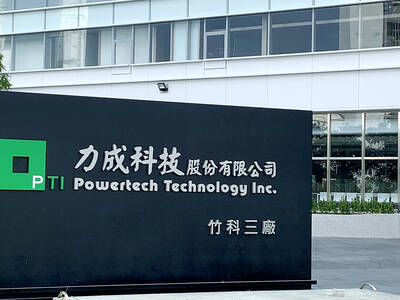Spot prices for PC DRAM chips are expected to continue rising over the next two months, because of a supply constraint following a fire at an SK Hynix Inc plant early this month, market researcher TrendForce Corp (集邦科技) said yesterday.
As of Thursday, concern about a chip shortage has driven spot prices up 20 percent since the fire broke out at the South Korean firm’s plant in Wuxi, Jiangsu Province, China, on Sept. 4, the Taipei-based research house said.
The spot price for mainstream DDR3 chips yesterday rose 0.64 percent to US$1.884 per unit, according to the real time pricing posted on TrendForce’s Web site.
Trendforce expects SK Hynix, the world’s No. 2 DRAM supplier, to take at least two months to restore full operation at the plant, as the fire had destroyed some key equipment in the clean room and the smoke had contaminated other machines.
“As the blaze erupted in the clean room, it will be very difficult to recover damaged manufacturing equipment in the short term,” TrendForce said in a report released yesterday.
SK Hynix has sent about 100 experts and engineers from its headquarters in Icheon, South Korea, to fix the problem, it said.
Damage like this usually takes three to six months for a full recovery, TrendForce said, citing comments from unidentified semiconductor equipment experts.
“The production disruption will impact supply of DRAM [chips] to a certain extent,” TrendForce said.
Some PC makers have turned to Samsung Electronics, Micron Technology Inc and Taiwanese chipmakers to secure their chip supply, while others are even looking to DRAM module makers for supply, the researcher said.
“A short supply could occur and limit shipments by PC makers in the fourth quarter,” TrendForce said.
SK Hynix’s Wuxi plant can churn out 130,000 DRAM wafers a month, accounting for 10 percent of the global output, it said.
TrendForce added that concern over the shortage would lend support to contract prices. The researcher originally expected contract prices to slide in the second half of this year due to weak PC demand.
Boosted by the price uptick, the stock prices of Taiwan’s major PC DRAM chipmakers Nanya Technology Corp (南亞科技) and Inotera Memories Inc (華亞科技) have soared about 16 percent and 15 percent to NT$4.20 and NT$13.50 respectively since Sept. 4.
The stock of the nation’s major DRAM module supplier, ADATA Technology Co (威剛), has also jumped about 11 percent during the period to close at NT$75.70 yesterday.

US sports leagues rushed to get in on the multi-billion US dollar bonanza of legalized betting, but the arrest of an National Basketball Association (NBA) coach and player in two sprawling US federal investigations show the potential cost of partnering with the gambling industry. Portland Trail Blazers coach Chauncey Billups, a former Detroit Pistons star and an NBA Hall of Famer, was arrested for his alleged role in rigged illegal poker games that prosecutors say were tied to Mafia crime families. Miami Heat guard Terry Rozier was charged with manipulating his play for the benefit of bettors and former NBA player and

The DBS Foundation yesterday announced the launch of two flagship programs, “Silver Motion” and “Happier Caregiver, Healthier Seniors,” in partnership with CCILU Ltd, Hondao Senior Citizens’ Welfare Foundation and the Garden of Hope Foundation to help Taiwan face the challenges of a rapidly aging population. The foundation said it would invest S$4.91 million (US$3.8 million) over three years to foster inclusion and resilience in an aging society. “Aging may bring challenges, but it also brings opportunities. With many Asian markets rapidly becoming super-aged, the DBS Foundation is working with a regional ecosystem of like-minded partners across the private, public and people sectors

BREAKTHROUGH TECH: Powertech expects its fan-out PLP system to become mainstream, saying it can offer three-times greater production throughput Chip packaging service provider Powertech Technology Inc (力成科技) plans to more than double its capital expenditures next year to more than NT$40 billion (US$1.31 billion) as demand for its new panel-level packaging (PLP) technology, primarily used in chips for artificial intelligence (AI) applications, has greatly exceeded what it can supply. A significant portion of the budget, about US$1 billion, would be earmarked for fan-out PLP technology, Powertech told investors yesterday. Its heavy investment in fan-out PLP technology over the past 10 years is expected to bear fruit in 2027 after the technology enters volume production, it said, adding that the tech would

YEAR-END BOOST: The holiday shopping season in the US and Europe, combined with rising demand for AI applications, is expected to drive exports to a new high, the NDC said Taiwan’s business climate monitor improved last month, transitioning from steady growth for the first time in five months, as robust global demand for artificial intelligence (AI) products and new iPhone shipments boosted exports and corporate sales, the National Development Council (NDC) said yesterday. The council uses a five-color system to measure the nation’s economic state, with “green” indicating steady growth, “red” suggesting a boom and “blue” reflecting a recession. “Yellow-red” and “yellow-blue” suggest a transition to a stronger or weaker condition. The total score of the monitor’s composite index rose to 35 points from a revised 31 in August, ending a four-month